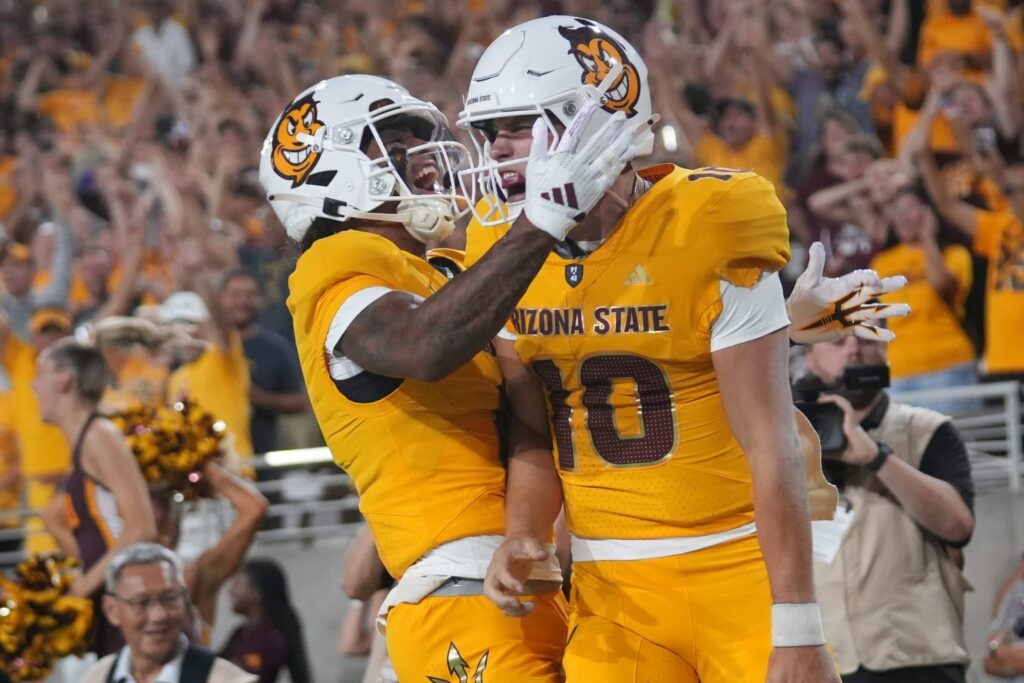
Arizona State University’s triumphs on the field have often come with high expectations, but few have sparked as much debate as the Sam Leavitt era. The freshman quarterback, hailed as a transformative talent, has led the Sun Devils into a make-or-break scenario: win and solidify their place in college football’s upper echelon, or lose and face scathing critiques about the program’s direction. Yet, while ASU fans revel in Leavitt’s success, others question the broader implications for college football, fairness, and the conference’s future.
A Bright Star Amid the Turmoil
Leavitt’s meteoric rise has been nothing short of spectacular. A natural leader and playmaker, his ability to deliver under pressure has turned Arizona State’s season around. His standout performances have kept the Sun Devils alive in a season where every win matters. With playoff hopes dangling by a thread, Leavitt has become the embodiment of hope for a program that many predicted would falter.
However, the controversy surrounding Arizona State’s success extends beyond the gridiron. Critics argue that the school’s ability to attract top-tier talent like Leavitt reflects deeper inequalities in college football. Smaller programs, strapped for cash and resources, cannot compete in an era where name, image, and likeness (NIL) deals reign supreme.
The NIL Divide: Is Arizona State Playing Fair?
Arizona State’s resurgence under Leavitt has reignited concerns about NIL deals creating a lopsided playing field. The quarterback reportedly secured lucrative endorsements upon signing, raising eyebrows about whether his recruitment was driven by financial incentives rather than athletic merit. Critics claim this growing trend undermines the integrity of college sports, where wealthier programs attract top talent while smaller schools are left behind.
For ASU, NIL deals may have paved the way for Leavitt’s arrival, but detractors argue that such tactics erode the spirit of competition. Should the Sun Devils triumph this season, will their success be seen as earned or as a product of an imbalanced system?
Winners and Losers in the Pac-12 Shakeup
The Pac-12 conference itself is another source of contention. With powerhouse programs like USC and UCLA departing for greener pastures, Arizona State finds itself at the forefront of a shifting landscape. While fans celebrate ASU’s potential dominance, rivals are quick to point out that the conference’s dilution benefits no one. A win for Arizona State might highlight Leavitt’s brilliance but also draw attention to a conference grappling with its waning relevance.
Programs like Washington State and Oregon State, left scrambling after realignment, have struggled to keep up. Critics argue that Arizona State’s success could further marginalize these schools, widening the gap between the haves and the have-nots.
What’s at Stake
For Sam Leavitt and Arizona State, a win solidifies their standing as a legitimate contender, silencing doubters and securing their spot in college football history. Yet, the fallout from such a victory could leave a sour taste for fans of smaller programs, questioning whether the sport they love still values underdog stories or has become a playground for the privileged few.
The debate surrounding Leavitt and Arizona State highlights broader issues in college sports: the impact of NIL deals, the effects of conference realignment, and the growing divide between major programs and those left behind. As the Sun Devils prepare for their next battle, the stakes are higher than ever—not just for them, but for the future of college football itself.
Is this the new era of college football? Or is Arizona State’s success a sign of everything wrong with the sport today?




